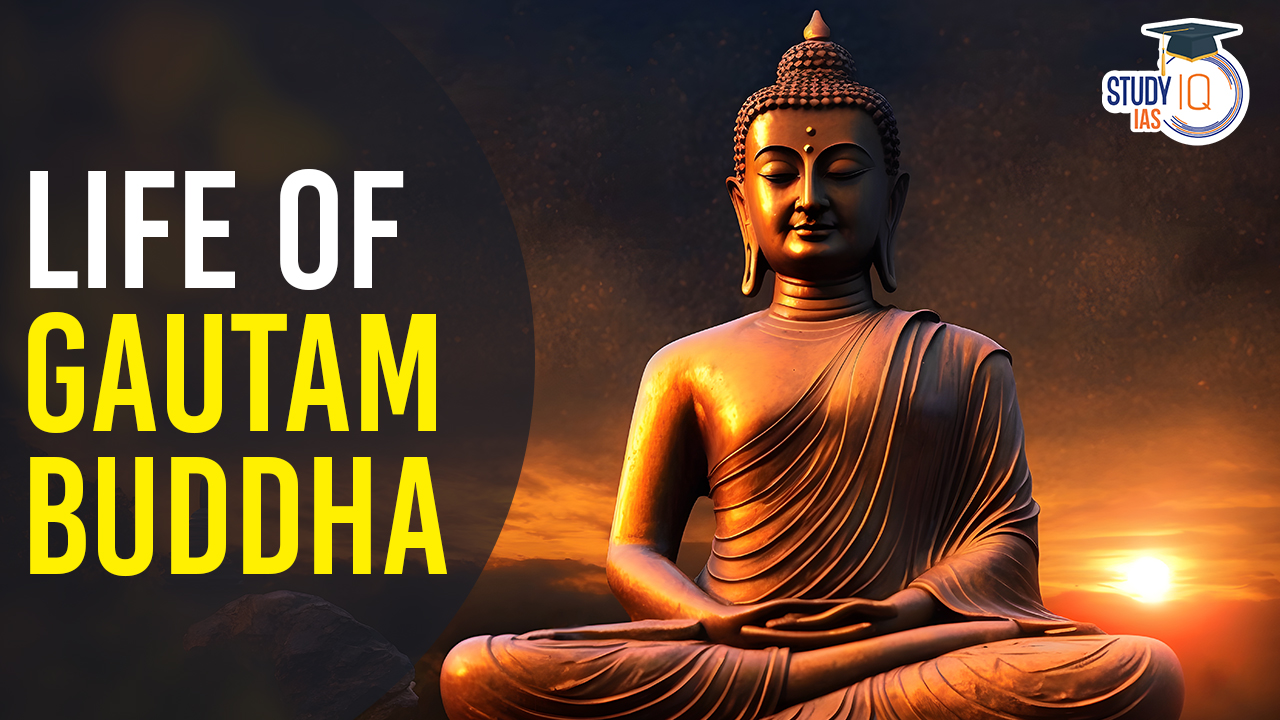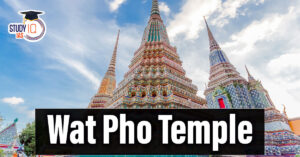Table of Contents
Gautam Buddha, or Siddhartha Gautam, stands as a transformative figure in Asian spirituality, founding Buddhism with a profound impact on the region’s philosophical fabric. Life of Gautam Buddha epitomizes enlightenment, compassion, and the pursuit of inner peace. Renouncing princely comforts, he embarked on a quest, ultimately attaining enlightenment under a Bodhi tree. Buddha’s teachings, encapsulated in the Four Noble Truths and the Eightfold Path, continue to resonate globally, shaping a legacy that transcends borders and time.
We’re now on WhatsApp. Click to Join
Life of Gautam Buddha
Siddhartha Gautam was born around 563 BCE (the exact date is uncertain) in Lumbini, present-day Nepal. His father, King Suddhodana, ruled the Shakya clan, and his mother, Queen Maya, died shortly after his birth. Legend has it that astrologers predicted two possible paths for the young prince: he would either become a great king or a great spiritual leader.
In an attempt to shield him from the sufferings of the world, Siddhartha’s father raised him in luxury and kept him within the palace walls. Despite the efforts to create a perfect life, Siddhartha felt a deep sense of dissatisfaction and curiosity about the world beyond the palace.
The Four Sights
When Siddhartha was around 29 years old, he ventured outside the palace, and it was during these excursions that he encountered the “Four Sights” — an old man, a sick man, a corpse, and a wandering ascetic. These encounters exposed him to the realities of human suffering, illness, and death, prompting him to question the nature of existence and the meaning of life.
The Great Renunciation
Driven by a profound desire to understand the nature of suffering and find a solution, Siddhartha made a life-changing decision. He renounced his princely life, left his family, and set out on a spiritual quest as an ascetic. For several years, he practiced severe austerity and meditation under various teachers but found no ultimate solution to end suffering.
The Enlightenment
Realizing that extreme asceticism was not the path to enlightenment, Siddhartha decided to pursue a middle way. He sat under a Bodhi tree in Bodh Gaya and vowed not to rise until he attained enlightenment. After intense meditation, on the night of the full moon in May, Siddhartha achieved enlightenment and became the Buddha, which means “the awakened one” or “the enlightened one.”
During his enlightenment, Buddha gained profound insights into the nature of suffering, the cycle of birth and death (samsara), and the path to liberation (nirvana). His teachings, known as the Dharma, centered on the Four Noble Truths and the Eightfold Path as a guide to end suffering and attain enlightenment.
Buddha’s Teaching: The Dharma of Liberation
Gautam Buddha’s teachings, known as the Dharma, form the core of Buddhism, providing a comprehensive guide for individuals seeking liberation from suffering. Central to his teachings are the Four Noble Truths and the Eightfold Path, offering a profound understanding of the nature of existence and a practical roadmap to attain enlightenment.
The Four Noble Truths
- Dukkha (Suffering): Buddha’s first truth acknowledges the inherent suffering in human existence – physical and mental anguish, dissatisfaction, and the impermanence of joy. Recognizing suffering is the first step toward transcending it.
- Samudaya (Cause of Suffering): The second truth identifies craving and attachment (tanha) as the root causes of suffering. Attachment to desires, possessions, and the illusion of a permanent self leads to dissatisfaction and suffering.
- Nirodha (Cessation of Suffering): The third truth offers hope by asserting that the cessation of suffering is possible. By eliminating craving and attachment, individuals can attain a state of liberation and inner peace (nirvana).
- Magga (Path to the Cessation of Suffering): The fourth truth outlines the Eightfold Path, a practical guide to ethical and mental development leading to the cessation of suffering.
The Eightfold Path
- Right Understanding (Samma Ditthi): Grasping the Four Noble Truths and understanding the nature of reality.
- Right Intention (Samma Sankappa): Cultivating wholesome thoughts and intentions that align with the path to liberation.
- Right Speech (Samma Vaca): Engaging in truthful, compassionate, and harmonious communication.
- Right Action (Samma Kammanta): Adhering to ethical conduct and engaging in actions that promote well-being and avoid harm.
- Right Livelihood (Samma Ajiva): Choosing a livelihood that aligns with ethical principles and does not cause harm to others.
- Right Effort (Samma Vayama): Exerting diligent effort to cultivate positive qualities, overcome negative tendencies, and maintain a balanced mind.
- Right Mindfulness (Samma Sati): Developing awareness of one’s thoughts, feelings, and actions in the present moment, fostering clarity and understanding.
- Right Concentration (Samma Samadhi): Cultivating focused and tranquil states of mind through meditation, leading to heightened awareness and insight.
Three Marks of Existence
Buddha also expounded on the Three Marks of Existence, emphasizing the impermanence (Anicca), unsatisfactoriness (Dukkha), and the absence of a permanent self (Anatta) in all phenomena. Understanding these marks deepens one’s insight into the nature of reality and supports the journey towards liberation.
Buddha’s teachings are not confined to theoretical knowledge but are a practical and transformative guide for individuals seeking a path to enlightenment. The Dharma continues to inspire millions worldwide, fostering mindfulness, compassion, and a profound understanding of the interconnectedness of all existence.
Gautam Buddha in Hinduism
In Hinduism, Gautam Buddha is often regarded with reverence and respect, but the interpretations of his role vary within the diverse Hindu traditions. While Hinduism and Buddhism share historical, cultural, and philosophical roots, they are distinct religions with unique doctrines and practices.
- Avatar of Vishnu: In certain Hindu traditions, Gautam Buddha is considered an avatar of Lord Vishnu, believed to incarnate to restore cosmic order (dharma) during times of disruption.
- Syncretism of Ideas: Buddhist concepts, including meditation, non-violence (ahimsa), and the pursuit of self-realization, have influenced certain Hindu texts, showcasing a cultural and philosophical overlap between the two traditions.
- Respect as a Wise Teacher: While not worshipped as a deity, Gautam Buddha is often acknowledged within Hinduism as a wise teacher and enlightened being. His ethical and spiritual teachings are respected for their insights.
- Integration of Pilgrimage Sites: Pilgrimage sites associated with Gautam Buddha, such as Lumbini, Bodh Gaya, Sarnath, and Kushinagar, are revered by both Hindus and Buddhists, emphasizing a shared cultural and historical heritage.
- Diversity of Beliefs: Hinduism’s diverse nature means that interpretations of Buddha’s role vary among Hindus. While some integrate Buddha into their pantheon, others may not actively incorporate Buddhist elements into their practices.
Gautam Buddha’s Death and Legacy
Gautam Buddha passed away at the age of 80 in Kushinagar, India, achieving parinirvana, which is the final liberation from the cycle of birth and death. His teachings continued to spread and evolve, giving rise to different schools of Buddhism.
The impact of Gautam Buddha’s life and teachings extends far beyond his historical context. Buddhism has become a global spiritual tradition, influencing art, philosophy, and practices that promote mindfulness and compassion. The story of Siddhartha Gautam’s journey from a privileged prince to the enlightened Buddha serves as an enduring symbol of the human quest for meaning and inner peace.
Gautam Buddha UPSC
Gautam Buddha, born around 563 BCE, founded Buddhism, emphasizing enlightenment, compassion, and inner peace. Renouncing luxury, he attained enlightenment under a Bodhi tree, revealing the Four Noble Truths and the Eightfold Path. His teachings, part of the Dharma, guide liberation from suffering. While not a deity in Hinduism, some see him as a Vishnu avatar. Pilgrimage sites are revered in both religions, reflecting a shared heritage. Buddha’s legacy persists globally, impacting art, philosophy, and the pursuit of mindfulness.


 Chittorgarh Fort: Mining Ban within 10 k...
Chittorgarh Fort: Mining Ban within 10 k...
 PM Modi visits Wat Pho Temple in Bangkok
PM Modi visits Wat Pho Temple in Bangkok
 Buddhism History, Origin, Sect, Councils...
Buddhism History, Origin, Sect, Councils...





















